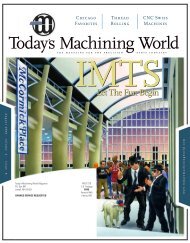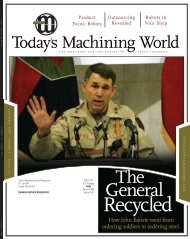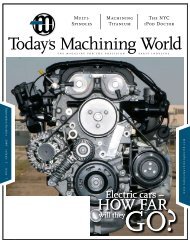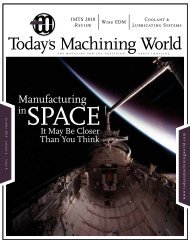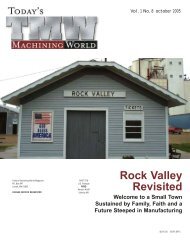A Night at the - Today's Machining World
A Night at the - Today's Machining World
A Night at the - Today's Machining World
Create successful ePaper yourself
Turn your PDF publications into a flip-book with our unique Google optimized e-Paper software.
“<br />
how it works<br />
By Barbara Donohue<br />
Competing Successfully<br />
Using Older Equipment<br />
You can do a lot with wh<strong>at</strong> you have—and th<strong>at</strong> doesn’t mean just your machines.<br />
In <strong>the</strong>se tough economic times you’re no doubt looking<br />
<strong>at</strong> how to bring in new business and increase revenue. As<br />
customers push hard for faster deliveries and lower prices,<br />
and move toward sending work offshore, wh<strong>at</strong> can you do<br />
to compete? Buying new machines may not be feasible, so<br />
wh<strong>at</strong> can you do to increase orders and raise productivity<br />
with your existing machines, without spending a lot of money?<br />
Revival of a screw machine house<br />
“We are not giving up on <strong>the</strong> industry,” said M<strong>at</strong>t Corcoran,<br />
president of W<strong>at</strong>erbury Screw Machine Products Company,<br />
W<strong>at</strong>erbury, Conn. “R<strong>at</strong>her, we’re focusing on wh<strong>at</strong> we’ve got here.”<br />
A year and a half ago, W<strong>at</strong>erbury Screw Machine Products<br />
was definitely feeling <strong>the</strong> effects of <strong>the</strong> recession. In business<br />
since 1938, <strong>the</strong> company has been led by third-gener<strong>at</strong>ion<br />
owner Corcoran since 1988. The shop, in <strong>the</strong> same loc<strong>at</strong>ion<br />
for many years, runs cam-type, single- and multispindle<br />
screw machines: Davenport, Acme-Gridley, Brown & Sharpe.<br />
“Nothing is computerized,” said vice president Charlie<br />
Smith. The company makes products mainly for <strong>the</strong> electrical<br />
switch industry—lots of toggles, nuts and o<strong>the</strong>r small<br />
parts, primarily in brass. Surprisingly, 90 percent of <strong>the</strong>ir<br />
production is used in Mexico and Costa Rica, Corcoran said.<br />
Smith, also a third-gener<strong>at</strong>ion machinist, joined <strong>the</strong><br />
company a year and a half ago. Since <strong>the</strong>n, he and Corcoran<br />
have figured out how to bre<strong>at</strong>he new life into <strong>the</strong> business<br />
and have seen revenue increase by a factor of two and a half.<br />
The changes <strong>the</strong>y made could work for many shops th<strong>at</strong><br />
are feeling <strong>the</strong> pinch.<br />
The right people<br />
Corcoran and Smith restructured <strong>the</strong>ir personnel, building<br />
a workforce willing to work, pitch in, cross train on different<br />
machines, and stay positive. When <strong>the</strong> setup person for<br />
<strong>the</strong> 1 1/4” N<strong>at</strong>ional Acme multi-spindle became seriously<br />
ill, Smith learned how to set it up. Then <strong>the</strong>y made sure<br />
someone else learned. “The guy with 20 years on a<br />
Brown & Sharpe can train to be an Acme setup guy,” Smith<br />
said. “It used to be ‘my machine.’” Not any more.<br />
“They’ve got to have a sense of urgency: ‘We’ve got to get<br />
th<strong>at</strong> machine back up,’” Smith said.<br />
“We hire on <strong>at</strong>titude,” Corcoran said.<br />
As sales have grown, <strong>the</strong> company has been able to<br />
hire, going from 24 or 25 employees to 43. “We’re providing<br />
good-paying manufacturing jobs in a down economy,”<br />
Corcoran said.<br />
“We go on three principles,” Corcoran said. “We pay a fair<br />
wage, we provide good health benefits, and we understand<br />
th<strong>at</strong> life doesn’t revolve around work.” Workers go to <strong>the</strong>ir<br />
kids’ games, for example, as long as <strong>the</strong>y don’t abuse <strong>the</strong><br />
privilege.<br />
Stretch to meet <strong>the</strong> market<br />
“We quoted parts th<strong>at</strong> we previously wouldn’t have because<br />
<strong>the</strong>y were too difficult,” Corcoran said. Now <strong>the</strong>y can quote<br />
thin-walled parts, long parts, and different m<strong>at</strong>erials like<br />
steel and stainless steel in addition to <strong>the</strong> brass and aluminum<br />
<strong>the</strong>y have traditionally machined.<br />
“We run big or small orders,” Corcoran said. How small and<br />
how big? “From 50 or 100 parts, up to 9 million,” Smith said.<br />
Tweak your process<br />
Engineering <strong>the</strong> processes has cut cycle times. Smith pointed<br />
to a Davenport making small brass parts. This part went from<br />
a cycle time of 2 seconds to half a second. How? It had been<br />
using a steel-threading method, he said, so changing to a<br />
brass-threading method saved time. Also, he reduced <strong>the</strong><br />
drilling time by half using a rot<strong>at</strong>ing drill instead of a fixed one.<br />
A thin nut made on a Davenport is now machined four <strong>at</strong><br />
a time, connected end-to-end. Then a multi-blade cutoff saw<br />
separ<strong>at</strong>es <strong>the</strong>m—so four parts fall per cycle. “If you can go<br />
from 1000 parts per hour to 4000, why not?” said Smith.<br />
For flexibility, <strong>the</strong>y plan tooling so a job can run on different<br />
machines. For example, one part runs on an Acme<br />
November/December 2010 19<br />
using older equipment



